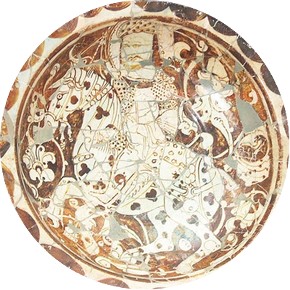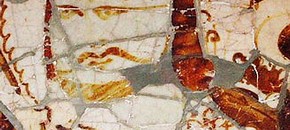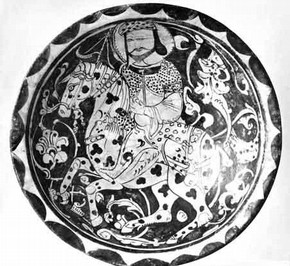Lustre dish, Iran, late 12th century. Museum no. C.7-1947. In its 'original' state
Believed to have been made in Iran around 800 years ago, it was considered one of the prime pieces of lustre-decorated pottery. I've covered lustre ware in more depth in another blogpost, but it was one of the most expensive and sophisticated technique in Arabic pottery at the time, adding to the value of the item. The clay, glaze, shape and style of the bowl all corroborated its Iranian origin from the town of Kashan, where lustre pottery was a specialty.
However, as Arthur Lane, Keeper of Ceramics for the V and A studied the bowl in his seminal book, Early Islamic Pottery, he became more aware of the Egyptian influence in the subject matter (particularly the non-Iranian style of the painting of the head with its square head and pointed beard - in comparison to the normal 'moon-face' of Iranian beauty). With the contrasts clear, he argued that this bowl had instead come to Iran from Egypt in the 12th century.

Lustre dish, Iran, late 12th century. Museum no. C.7-1947. After the overpainting of the 'restoration' had been removed
Whilst he was right about it's origins, there were further layers to uncovering it's authenticity. The overpainting of the bowl was removed in a cleaning, and the uncovered that the dish was in fact never one piece, but stitched together from fragments that have been pieced together and carefully joined as the painting on them doesn't join.
With all the fragments dating back to the same place, it is clear that they are all genuine 12th century Iranian lustre, that have been carefully put together from different objects. Experts now believe that at least two, if not more broken pieces were used to create one 'complete vessel' possible with the use of tiles as well to satisfy the demands of collectors and museums. The work was often so masterfully done, especially with additional glaze on top, that it fooled even the best experts such as Arthur Lane.
This kind of faking, where original bits are 'lashed up' (to use the trade jargon), is common in Islamic pottery, where many fragments are found on archaeological sites all over the Middle East, but complete vessels are a rarity.

Dish, lustre pottery, Iran, late 12th century, (Museum no. C.7-1947). Detail of the face showing its reconstruction
Source: http://www.vam.ac.uk/content/articles/r/real-or-fake/




Post Comment
Post a Comment